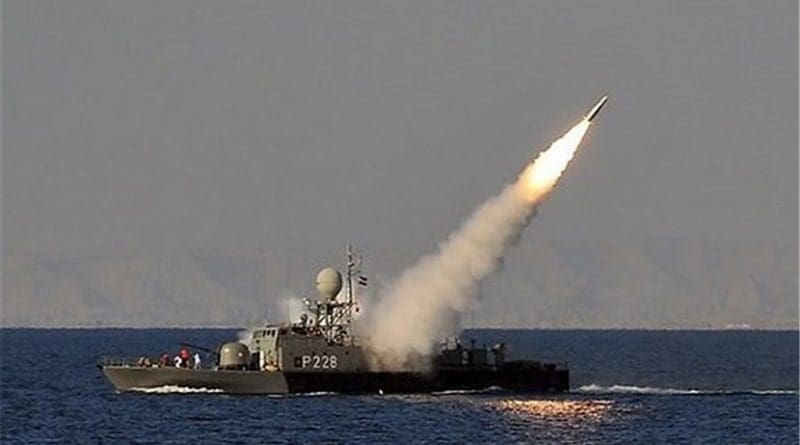Why Knowing Iran’s Asymmetric Capabilities Matters – Analysis
Anxiety has risen in recent days over what exactly the US will do next with Iran, given a Pentagon threat assessment that warned of pending attacks. Regarding Tehran and its proxies’ military capabilities, Iran relies on asymmetric tactics in order to achieve tactical gains over more sophisticated US weaponry. This threat exists but, with the US shifting its force posture quickly with additional strategic military assets, Washington is sending a message to Tehran that any asymmetric action will bring retaliation.
The threat to American or Gulf interests from Iran in terms of its asymmetric strategies is a result of the lessons it learned from not only the Iran-Iraq war, but also the US experiences in Afghanistan and Iraq. Iran’s capability to kill almost 600 American soldiers with the use of explosively formed penetrators (EFPs) certainly makes it an asymmetric weapon of choice.
For Iran, such warfare is a strategy for dealing with the considerable capabilities of the enemy. A prominent example of this kind of warfare is the tactics employed by Hezbollah during the 2006 Lebanon war. For Tehran today, since the enemy has considerable technological capabilities, and since Iran is still at a disadvantage in comparison despite the progress made in the area of equipment, its only way to confront its enemies successfully is to adopt the strategy of asymmetric warfare.
The activity of Iran’s militias in Iraq and their lessons learned from the Syrian battlefield are also now part of the landscape of how it may strike back. It should also be recalled that one of the first groups to threaten American interests was Kata’ib Hezbollah, which was reportedly the recipient of millions of dollars from Qatar through a ransom payment for kidnapped royals.
The maritime aspect of Iran’s asymmetric capabilities remains. The Iranian navy put into place a multi-layered framework comprising conventional and asymmetric subsurface, surface and airborne systems that can impact open access to Arabian Gulf shipping lanes. Hence, talk of the closure of the Strait of Hormuz is notable but, in most scenarios, any closure would not last for more than 30 days.
There are also large numbers of anti-ship missiles outfitted on various types of launch platforms. Iran has also taken measures to mitigate the vulnerability of even small naval units to air and missile attack. And never forget that those who operate this equipment are ready to commit suicide for their cause with kamikaze attacks.
Today, the Islamic Revolutionary Guard Corps (IRGC) forces are outfitted with customized or purpose-built high-tech equipment that boosts their asymmetric warfare capabilities. They have also enhanced their ability to conduct electronic warfare so as to disrupt the enemies’ command, control, communications and intelligence. The IRGC has also been investing in the means to gather more timely intelligence, as well as engage in more effective counterintelligence and deception operations, including but not limited to the greater use of unmanned aerial vehicle (UAV) technology.
Importantly, since the White House declared the IRGC a foreign terrorist organization, all of the group’s networks that had been previously off-limits have suddenly been brought into the public eye. Iran has been working hard at threatening its neighbors, hence America’s large show of force.
Exercises conducted by the IRGC demonstrate its capability to raid or attack key export and infrastructure facilities, tankers and shipping vessels. The IRGC can threaten shipping lanes in the Gulf, Gulf of Oman and the Caspian Sea through the application of a wide variety of assets it has at its disposal, including submarines, smart torpedoes, smart mine capability (free-floating and dumb mines), and land-based, long-range anti-ship missiles strategically based on the mainland, islands and ships.
Furthermore, attacks on tankers, shipping and offshore facilities by naval guards could also be conducted by combat aircraft armed with anti-ship missiles. Again, many of these actions could be suicide missions.
Iranian forces can carry out extensive raids against Gulf shipping, carry out regular amphibious exercises with the land branch of the IRGC against objectives like the islands in the Gulf, and conduct raids against countries on the southern Gulf coast.
Iran could also launch a coordinated attack involving explosives-laden remote-controlled boats, swarming speedboats, semi-submersible torpedo boats, kamikaze UAVs, midget and attack submarines, and shore-based anti-ship missile and artillery fire.
Another scenario could involve “swarming” a US-escorted convoy or surface action group transiting the Strait of Hormuz with barrages of rockets with cluster warheads used to suppress enemy defensive fire and carrier air operations.
Such scenarios have been run by the Pentagon and the results were not particularly favorable but, given the lessons learned, the protection necessary for a carrier battle group is now in place.
The IRGC often claims to conduct very large exercises, sometimes with 100,000 men or more. However, while the exact size of such exercises is unclear, they are often a small fraction of the IRGC’s claims. An important aspect of its exercises is the almost total absence of the regular Iranian navy in some cases; its functions are more oriented toward the classical tasks of sea denial and power projection in the Gulf and Strait of Hormuz. By displaying both its real and virtual military (e.g., naval) fighting capabilities through the electronic, printed and network media, and through endless official statements, Iran tends to achieve its politico-diplomatic and propaganda goals. These messages will become louder but will be muted quickly.


His “religio-political” talents notwithstanding, the writer appears to have stayed a little too long in the nouveau riche sheikhdoms of the Persian Gulf.
A 30day closure of the strait of Hormuz will send oil above a $100 a barrel. That should be enough to bring JCPOA back to life which is what the Iranians want.